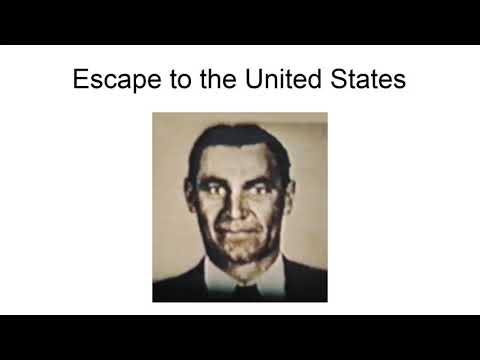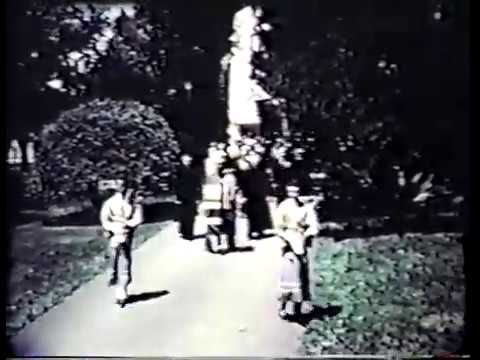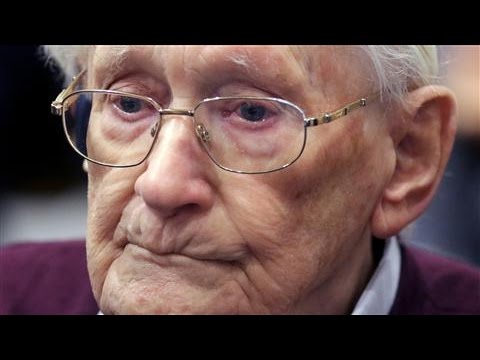Years after the war concluded, Nazis were hunted down and brought to justice, and that trend continues and will continue until they’re found or die of old age. Some of the better-known Nazis captured after the war are well-known, including Adolph Eichmann, Franz Stangl, and Josef Schwamberger. While they aren’t as well known as others, these ten were found in the nooks and crannies to face justice decades after their war crimes were committed and are presented in no particular order, as they’re all monsters. 10 Jews Who Fought In Hitler’s Nazi Army
10 Jakiw Palij
Four years after the war, Jakiw Palij emigrated to the United States, claiming he worked on his father’s farm during the war. Of course, that was a lie, and instead of working as a farmhand, Palij worked as an armed guard at the Trawniki concentration camp in Nazi-occupied Poland. The Trawniki camp was a forced-labor concentration camp that held Jewish prisoners, but it was more than that. The camp was also one of the locations the Schutzstaffel (SS) trained to hunt down and kill Polish Jews. As for Palij, it took a long time, but he was finally outed by a senior historian from the U.S. Holocaust Memorial Museum. In 2003, a federal judge stripped Palij of his American citizenship, and the following year, he was ordered deported. Despite the order, no country was willing to receive the Nazi war criminal. Then, in 2018, Germany finally relented and accepted Palij — he was 94-years-old at the time. In 2019, Palij passed away, and while he was stripped of his American citizenship and finally deported, he was never charged for any crimes related to his involvement in the Holocaust. Regardless, he was outed, which served to properly vilify the man for nearly two decades before his death.
9 Hermine Braunsteiner Ryan
Hermine Braunsteiner Ryan was an SS Helferin, working as a female camp guard at the Majdanek and Ravensbrück concentration camps. She was dubbed the “Stomping Mare” and was known to be a cruel and monstrous woman. She hanged and whipped women to death and would throw children by their hair onto trucks as they were carted off to gas chambers. She earned her nickname after she stomped an older woman to death with her boots. She was chased across the pond by Nazi hunter Simon Wiesenthal, who managed to track her down. Her path to the States began in Vienna before she headed to Canada, and finally, Queens. Wiesenthal and his associates finally found her playing housewife under the name “Hermine Ryan.” In 1973, she became the first Nazi extradited from the US to Germany. She was tried in Düsseldorf, beginning in 1975, and her trial took more than five years. She was found guilty and was given a life sentence, which began in 1981. After she lost a leg to diabetes in 1996, she was released from prison. She passed away three years after her release.
8 Mykolaiovych “John” Demjanjuk
Mykolaiovych “John” Demjanjuk was a Ukrainian member of the Red Army who served as a Trawniki man (recruited POW) for the Nazis. He worked as a camp guard at the Sobibor extermination camp, Majdanek, and Flossenbürg. After the war, he emigrated to the United States and became a naturalized citizen in the 1950s. He worked at a Ford automotive plant in Ohio, but in the 1980s, he was misidentified as a notoriously cruel guard known as “Ivan the Terrible.” He was tried and convicted, but in 1993, the Israeli Supreme Cours overturned the conviction. His legal troubles didn’t end there, though, as it was known that he was a concentration camp guard even if he wasn’t who the world thought he was. As a result, his citizenship was revoked in 2002, and Germany extradited him in 2009, claiming he was an accessory to more than 27,900 counts of murder. That was the number of people killed under his “guard” at Sobibor. In 2011, he was convicted, which set a new precedent for convicting guards/collaborators where no direct evidence of their involvement in murder was available. He was given a five-year sentence but died the following year.
7 Fyodor Fedorenki
Fedor Federenko was mobilized into the Soviet Army shortly before the Germans advanced into Soviet territory. He was captured and taken to Chelm, Poland. He was recruited into an auxiliary police unit, serving Nazi Germany, and was taken to the Treblinka extermination camp for training. While there, Fedorenki was promoted to a position of authority over 200 men. Their job was to shave, strip, beat, and gas prisoners brought to the camp. He later trained as a marksman and executioner who took part in the “cleaning out” of the Warsaw Ghetto, though he claimed he was issued a rifle but never fired it. After the War, Fedorenki escaped to the United States, where he was suspected of being a Nazi war criminal. Regardless, he was given citizenship and retired to Miami in 1973. Five years later, he was arrested, denaturalized, and by 1984, he was the first Nazi war criminal deported from the United States to the Soviet Union. Following a nine-day hearing, he was found guilty of treason and having taken part in mass executions. He was sentenced to death and was executed for his crimes in 1987 — 42 years after the war ended.
6 Karl Linnas
Karl Linna was the Commandant of the Nazi concentration camp at Tartu in Estonia. During his time in that position, he shot men, women, and children while he oversaw the camp’s operations. When the Soviets pushed the Germans out of Estonia, Linnas fought alongside the German army and was wounded. He remained in various displaced persons camps in Germany before making his way to the United States in 1951. Between ‘51 and 1979, Linna worked as a land surveyor in Greenlawn, New York. While living in the States, the USSR worked tirelessly to bring him to justice. In 1962, he was tried, convicted, and sentenced to death in absentia by a Soviet court. In 1981, the Federal District Court in Westbury, NY stripped him of his citizenship and ordered his deportation. He fought this for years, but the Supreme Court refused to hear his final appeal, and in 1987, Linnas was flown to the USSR. Unfortunately, he never stood trial. He was in the Soviet Union for three months before he died in a prison hospital while awaiting trial. Had his trial taken place, there’s little doubt he would have been found guilty, sentenced to death, and executed.
5 Arthur Rudolph
Arthur Rudolph was brought to the U.S. via Operation Paperclip. That operation brought German scientists to the U.S. to help develop the American space program and other rocketry-related technology. In that respect, Rudolph helped develop the Pershing missile and Saturn V rocket. Scientists brought to the States under Operation Paperclip were generally forgiven for their actions during the war, but Rudolph is a special case. In 1943, he began production of the V-2 at the Mittelwerk facility. He was in charge of production, which relied on forced labor via the Mittelbau-Dora concentration camp. It has been estimated that as many as 20,000 prisoners died building the rockets — information that the U.S. Government buried until 1982. When this came to light, he signed a confession/agreement with the OSI to renounce his U.S. citizenship and leave the country. Ultimately, Rudolph wasn’t prosecuted for his crimes and was granted citizenship in West Germany. He was stripped of his NASA Distinguished Service Medal, and when he visited Canada, he was expelled from the country. He died from heart failure in 1996 while living in Germany.
4 Valerian Trifa
Leading up to WWII, Valerian Trifa was a member of the Iron Guard, a Romanian fascist group that helped provoke the Legionnaires’ Rebellion of 1941. A staunch anti-semite, Trifa worked hard to instigate violent riots against Bucharest’s Jewish community and was responsible for the deaths of hundreds of Jews. He spent most of the war as a detainee of the Nazis with privileged status, and when the war ended, he emigrated to the United States. He rose to prominence to lead the Romanian-American Orthodox community against the Orthodox Church in Communist Romania. His crimes leading up to the war remained unknown unti l 1975, when the U.S. Department of Justice began an inquiry against Trifa. He was stripped of his American citizenship before being allowed to move to Portugal. By ‘84, Portugal declared Trifa an “undesirable” due to his ties with Fascism. The country forced him to leave, offering him three months to make that happen. He fought deportation for several years through the courts. In 1972, while the process was still underway, Trifa died of a heart attack.
3 Friedrich Karl Berger
During the Winter of 1945, Friedrich Karl Berger served as a Nazi guard at the Meppen sub-concentration camp. During that time, he guarded the prisoners as they were forced to work in “atrocious” conditions, working many “to the point of exhaustion and death.” When Allied forces approached the camp, the Nazis abandoned it, and Berger helped move prisoners to the Neuengamme main camp. This process resulted in the deaths of some 70 prisoners under his watch. When the war ended, Berger made his way to the United States in 1959, where he remained until 2020. When his case was brought to light, Berger admitted to working as a guard at the Neuengamme concentration camp system but said he never witnessed any killings or prisoner abuse. While German prosecutors dropped their case against him for lack of evidence, he was nonetheless deported from the United States in November 2020. Berger, who was 95-years-old at the time of his deportation, expressed astonishment at what was happening to him. “After 75 years, this is ridiculous. I cannot believe it. You’re forcing me out of my home.” Despite his protests, the U.S. no longer wanted an admitted Nazi concentration camp guard residing within its borders.
2 Laszlo Csatáry
Laszlo Csatáry worked as the Commander of the Royal Hungarian Police in the city of Kassa. In 1944, he organized the deportation of 15,700 Jews to the Auschwitz concentration camp. He was also accused of using his authority and position to brutalize his city’s people while also using prisoners in forced labor camps. His crimes were well known to Kassa’s people, and in 1948, he was convicted in absentia for war crimes by a Czechoslovakian court. The following year, he fled to Canada, claiming to be a Yugoslavian national. He set himself up in Montreal, where he became an art dealer, and by 1955, he became a Canadian citizen. He enjoyed that privilege right up until 1997 when Canada revoked his citizenship for lying on his application. He was permitted to leave the country but wasn’t charged for his crimes. Csatáry ended up in Budapest, where his identity was revealed in 2011. After this, Slovakia was ready to prosecute him for the deportation of nearly 16,000 people to Auschwitz. Ultimately, he died in custody while awaiting trial, having “eluded justice and punishment” to the end.
1 Hans Lipschis
Hans Lipschis was a Waffen-SS member who spent most of the war working at the Auschwitz concentration camp. When the war ended, he found his way to Chicago, where he remained until 1983. He was deported for “lying about his Nazi past” and eventually settled in Germany. The Simon Wiesenthal Center placed him fourth on its most-wanted list, but he eluded capture for an incredibly long time. He wasn’t captured until 2013, when he was 93-years-old. Lipschis admitted to being stationed at the camp, but he claimed he worked as a cook, not a guard. When he was arrested, there was more than enough evidence, linking him to the camp from 1941 to 1945. Unfortunately, there was no direct evidence implicating him in taking part in any murders. The German government sought to bring charges against him in the same manner John Demjanjuk was convicted for accessory to murder. Unfortunately, due to his age and poor health, he was ruled unfit to stand trial for his crimes. He had dementia, so the court never opened the trial. Despite being caught, he avoided justice and passed away in 2016 at the age of 96. 10 Famous People Who Were Nazi Sympathizers Read More: Twitter Facebook Fiverr JonathanKantor.com
























